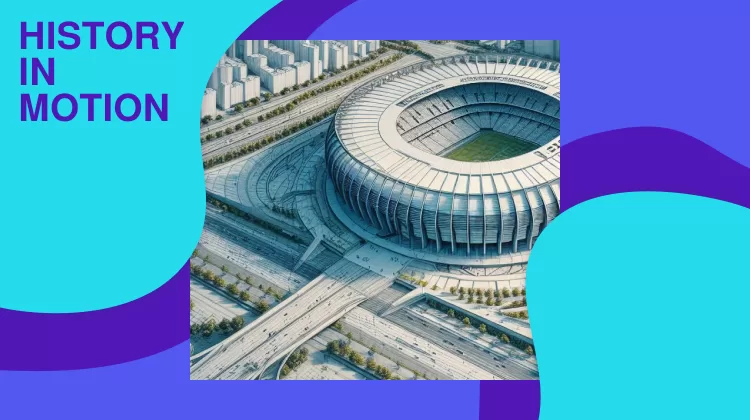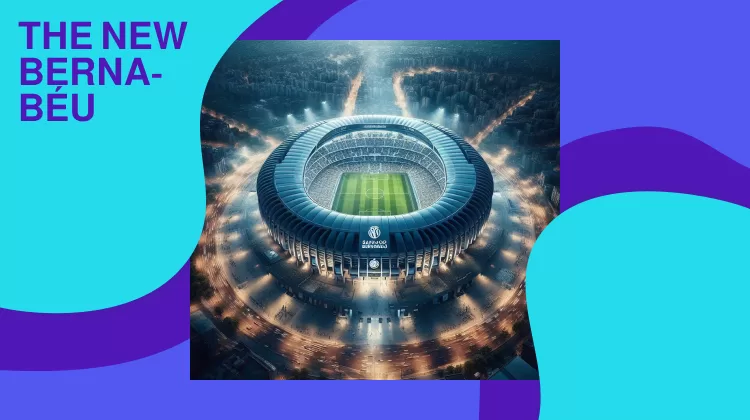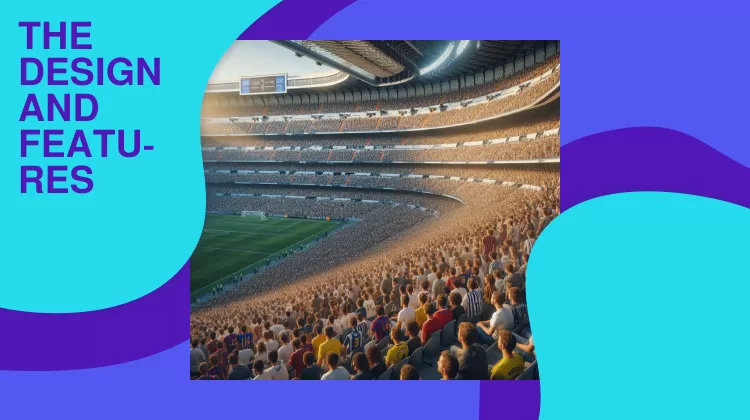Santiago Bernabeu St. Gradual guide House of the Madrid Legends
Introduction
The Santiago Bernabéu Stadium is more than just a soccer stadium; it stands as an historic monument and the nerve center of Real Madrid Football Club. This landmark and historic document in the beautiful Spanish city Madrid, Spain saw infinity of memorable moments regarding football. Sitting 81,044 spectators it is the largest stadium in Europe and ranks amongst football fans all around the globe as being a mecca for any follower of this sport. Read on to learn more about the history of Camp Nou, some curious facts regarding its architecture and cultural importance and discover all you need in order to experience this magnificent stadium. Get ready to enter a world that never ends at the Santiago Bernabéu, where glory from yesterday meets with future.
So this football stadium has lots of histories, we could say that for how prestigious santiago bernabeu is as their home soil is set with real madrid fans. Celebrated for its wonderful ambiance and storied history, the stadium has borne testimony to several of football’s most marvelous moments. A venue of groundbreaking matches, memorable victories and impressive events that offer an emblematic image to the Bernabéu:emblem of excellence and ambition. The guide gives an army of elaboration to the stadium and is an insight overview for fans or others visiting. Whether you’re about to make a visit or are just interested in finding out more about this iconic place, here’s all there is to know on the Santiago Bernabéu.
History in Motion: Changes for Santiago Bernabéu

Formation and Early Construction
The Santiago Bernabéu Stadium first opened on December 14, 1947. The stadium was named after former Real Madrid president Santiago Bernabéu and represented the club’s grand vision. Its building on the Paseo de la Castellana, reflected those great stadia; it was showing that a world championship football stadium had been built by this club. It may seem a modest stadium by today’s standards, but the cozy confines in New Jersey initially held 75,145 patrons–more than double what many current NFL stadiums accommodate. The stadium hosted many Real Madrid games, both domestic and international in the early years of its existence even within five years in official time they completed all of the dreams of fans – the home ground team had great success, UEFA awarded them plenty of times and the club’s president are always welcoming team’s fans.
The stadium was rebranded as the iconic venue we know today and named initially Nuevo Estadio Chamartín. Santiago Bernabéu was the inspiration behind a stadium of this scale, feeling that Real Madrid needed a better ground to house its ever-growing number of fans. 11 The spot on the Paseo de la Castellana was indicated by its perfect location in Madrid – spanish capital; it is a common meeting point that everyone can reach very quickly from everywhere.
The construction itself was an extraordinary task, one befitting a club as ambitious in spirit as Real Madrid. The original concrete and steel structure was an advanced expression of its time. Topics actions Share Related Articles On the first day of play, Real Madrid met Os Belenenses from Portugal in an inaugural 3-1 win. It was the start of a new era for Los Blancos as their Santiago Bernabéu Stadium would now be called an impregnable fortress. New stadium’s capacity and a new roof will make multiple european championship in process.
The stadium was expanded in the 1950s for the first time, capacity over.125,000 by then one of largest stadiums in the world. This growth was instrumental because that enabled many fans to watch how Real Madrid became a powerhouse in European football.
Modernization and growth
Throughout the years, there have been many improvements in Santiago Bernabéu Stadium regarding capacity and facilities. In 1950 and again in the 1980s, major facilities were built (such as adding tiers and better amenities). The stadium underwent its most significant renovation during preparations for the 1982 FIFA World Cup, with substantial increases in capacity and new technologies being commissioned. Such alterations not only enhanced the grandeur of the stadium but also safeguarded its reputation as a football coliseum.
The Santiago Bernabeu saw its moment protected in the 1982 FIFA world cup. The stadium was required to meet FIFA standards as one of the host venues. The result was major construction work with a roof over all seating, full press facilities and corporate boxes being added. These upgrades made the fan experience better and ensured that the stadium met international regulations. Seating capacity is good, but what’s better is the press areas, nearby restaurants and many football events that happen everyday.
In the decades that followed, additional modernization work was done. The 1990s and early-2000s welcomed the arrival of new modern comforts, including better seating arrangements, advanced security systems with greater accessibility for disabled fans. To cope with the changing requirements of football fans, infrastructure was steadily refurbished at the stadium. 5
The New Bernabéu Behind the Bend

A masterplan already in development by the president of Real Madrid is designed to turn Santiago Bernabéu into a 21st-century stadium. These changes included the addition of a retractable roof, 360 degree scoreboard and lots of tech driven enhancement. Sustainability is a central theme in future plans, including efforts to make the bowl more pathways and improve sustainability at Energy efficiency.mockito chi-shamayim patches.the This whilst ensuring their stadium, The Bernabéu, does not just compete but remains at the forefront of global football venues.
It pledges a new vision for the new Santiago Bernabéu. Plan of Restructuring The President of the Club Florentino Perez has laid out a wide and elaborate plan to change the stadium into an icon in modern times. The stadium also flaunts a retractable roof so any event can be held there in almost all weather conditions. The enhanced comfort for fans, combined with the expanded possibilities of staging a broader range of events including concerts and corporate gatherings alongside football matches.
A major new feature includes the 360-degree scoreboard, allowing fans to get a unique vantage of what is going on so they never miss a moment no matter which side of the ice their seats are located. The new feature is the latest improvement aimed at elevating fan-experience standards and maintaining leadership in stadium innovation!
Redevelopment is also sustainable! Other environmental-friendly features of the new Santiago Bernabéu include energy-efficient systems, waste management efforts and sustainable materials to reduce its carbon impact. The initiatives are a demonstration of Real Madrid’ s dedication to sustainability, and responsible estate management at their world-famous stadium.
Architectural Wonder – The Design and Features of the Bernabéu

Exterior and Surroundings
In black and white, the front perimeter surrounding it has always resembled something between a Roman wall (if slightly ruined) to – less romantically but perhaps more appropriately — an iron curtain. Situated on the vibrant Paseo de la Castellana, greatest club – Real Madrid’s stadium is incredibly well-placed for landmark and city attractions. Plaza de Lima Page and Padre Damián metro stations are among the well-served sites for visitors. It moves through Madrid unnoticed except for the very visible Real Madrid badge that appears right on its sleek front-end.
The exterior of the Estadio Santiago Bernabéu reflects its past and its future Inspired by surroundings in both nature and culture, the exterior incorporates a paean to regional landscape: glass-clad rooftop canopy that extends over all five unique seating areas while revealing glimpses of iconic Bryant Denny Stadium (10 seats at midfield on street level attn) imbedded below upper bowl steel trusses. Glass has been utilized to allow natural light into the interior of the house giving it a bright and inviting environment for fans.
The Paseo de la Castellana is a lively neighborhood with restaurants, cafes and shopping all around the stadium. One of the most visited streets in Spain, this vibrant boulevard is an essential part for any football fans but also hugely popular among tourists exploring Madrid. The stadium’s literal and logistical centrality-close to most key landmarks, transportation hubs, etc.-was supposed to place it at the heart of downtown.
Interior and Seating
Within, and around the ground is a tastily purposeful 81,000+ seating layout at Santiago Bernabéu Stadium. Arranged in a number of different areas including General Admission, Premium Seating and Hospitality Areas. The vibrant east side and south ends are also a haven for devoted Real Madrid fans. In addition, the interior of this stadium contains private VIP boxes too where elite guests can enjoy luxury and comfort.
As such, the plan of the interior layout is arranged so that all fans have a continuous field vision. There is a lot of time put into making sure the seating layout provides you with an excellent view from no matter where you are seated. The bowl – with the lower tiers notably close to the pitch for a more intimate experience and upper ones offering wide, overhead views of NFL action.
These include premium options such as the VIP boxes and hospitality suites, boasting a variety of world class amenities including private dining space, exclusive lounges with high quality food & beverage offerings to more personalized concierge services. Corporations can also enjoy the Real Madrid star treatment by choosing one of these zones as well… because heaven knows watching a live Real Madrid game on TV, especially in HD quality and accompanied with pictures of high-performance race cars speeding through magical clouds is nothing more than drinking for free beer from your own personal tap godvine.
Technological Innovations
Santiago Bernabéu has state-of-the-art stadium design technology A new retractable roof means the stadium will be suitable for all-weather play, with a 360 degree scoreboard giving fans around Sydney Showground Stadium unrivaled views of the action. Additional innovations encompass high-speed Wi-Fi, cutting-edge lighting systems and press facilities. All of this combined adds to the experience for fans who visit the Bernabéu, making sure that memories are made in each and every trip to Madrid.
A primary factor in the Bernabéu redevelopment project is technological innovation. Key feature: This state-of-the-art, retractable roof is the among most advanced in world stadia and ensures matches – including events such as Jason Derulo concert on 20 March -can continue uninterrupted by bad weather. This flexibility is key to retaining the stadium as a top-tier venue for football and non-football events in what can be considered one of New York’s most vibrant properties.
Another major addition, the 360-degree scoreboard provides real-time updates and visuals that bring fans close to the action. The technology enables sports fans in the stadiums to stay connected at all times, discouraging considerable loss of data and fan engagement.
This new technology support also includes high-speed Wi-Fi – which enables fans to stay connected during the game and share their experiences on social platforms while at the stadium, as well as cutting-edge lighting systems that improve both atmosphere and in-venue environment. Press facilities have also been brought up to the latest standards, plenty of room for all modern media platforms which follow events at the Bernabéu.
Beyond Soccer field and stands — The cultural Bernabéu

The Heart of Real Madrid
For Real Madrid, the Santiago Bernabéu is much more than simply their stadium; it represents an entire way of life. It merged a spirit and tradition of the one greatest football club around this world. The Bernabeu is a place of memories that make the backbone for Real Madrid’s history, from those iconic players to historical moments. The club’s offices and additional facilities within the stadium complex underlines its significance even more heavily.
From Zidane to Di Stefano, Feher calls it the “home of Real Madrid” and a monument representing an era that no other stadium will soon live up to. The stadium has been witness to some of the most iconic moments in football history, from injury-time heroics to wonder goals by all time greats. Alfredo Di Stéfano, Ferenc Puskás,Zinedine Zidane and Cristiano Ronaldo to name a few all took the Bernabéu turf by storm through years of unforgettable memories.
It is also at the heart of what Real Madrid do. It serves as the hub for all administrative and operational activities, with offices located within the stadium complex. The intimate link between stadium and club is what ensures the Bernabéu’s enduring centrality to Real Madrid, a sense that their home will be not so much described as defined long into the future.
Non-Football Use – A Stadium Multipurpose Usage
More than a pitch — the Santiago Bernabéu has functions as broad in scope as holding concerts and other non-footballing spectacles. The Bernabéu’s schedule also includes concerts, corporate gatherings and community events — all of which make a dent in Madrid’s social and economic calendar. The flexibility of the stadium for hosting other events further entrenches this as a community hub beyond football, contributing more to the local economy.
The flexibility in the Santiago Bernabéu is one of its own characteristics. The stadium is best known as the home of Real Madrid, but also hosts a variety of non-football events. In addition to club events, the Bernabéu hosted shows by global superstars like Simon and Garfunkel back in 1982, corporate conferences and a wide array of community activities that have proven it is capable of accommodating audiences other than football fans.
The stadium also provided a massive impact on the local community and economy. During games, as well all accompanying events that come with them, the local economy receives an enormous infusion of visitors – not only from this country and other parts of Europe but world-wide. At the same time, being a multi-purpose venue of Bernabéu helps to breed community through hosting various social and cultural activities.
Tours and Museum
Now, the Tour Bernabéu provides an engaging experience to attendees in order for them to see this history and come a little closer. The tour takes guests around the stadium, several illustrated sections of a museum, and exclusive areas like dressing rooms or team tunnels. All VIP packages are available on top of the normal ticket offerings. Get the most out of your visit by going early and checking out nearby restaurants and shopping on Paseo de la Castellana.
Also for every Madridista or football fan in general, visiting the Tour Bernabéu is a definite must do. The Bernabéu stadium tour is rich in history, providing a look behind the scenes of one of Europe’s biggest clubs. Guests can also check out the stadium, which includes areas such as where Real Madrid legends get ready to do battle in their dressing rooms and a look at the tunnel that leads players onto the pitch.
The museum displays are a real bonus, displaying an extensive range of trophies / memorabilia and interactive exhibits all based around the illustrious history of Real Madrid. The museum offers a complete vision of Real Madrid history from the birth of the club in 1902 to its current greatness as one of football’s leisure activities.
Matchday Experience
Watching a Real Madrid game at the Santiago Bernabéu is an experience like no other. Visit the club website for ticket details and purchase your tickets only from authorized vendors. On matchdays, the stadium is swarming with activity as supporters come together to cheer on their side. Get there earlier to soak up the atmosphere and check out some nearby sights like Plaza de Lima. To dine: There are plenty of local foods in the many restaurants and bars as well as a vibrant pre-match scene.
Few things can compare to a matchday at the Bernabéu. The buzz starts well before kick-off with fans descending to the stadium in numbers simply to revel in everything pre-match. Their pockets of the chants, flags and trumpet blasts spill out from streets that surround the Bernabéu to create a carnival atmosphere which is infectious.
If you’re looking for something to eat before the game, there are lots of dining options in and around TCF Bank Stadium. The line ranged from Spanish-style tapas to international dishes, and there are mainly everything you can think of. Moreover, quite a few restaurants and bars prepare individual matchday menus/promotions in order to create an even better atmosphere.
The venue itself is quite electric once you get inside the stadium. The atmosphere, the players of Real Madrid going out to start the game and that tension before a match is unique. Whether you’re a lifelong fan, or your first time in Madrid means checking another game off the bucket list…!
Conclusion
The Santiago Bernabéu Stadium is more than just a brick-and-mortar sports arena; it’s Real Madrid in its most distilled form. From its humble beginnings to the modern, cutting-edge facility it is today, Madrid’s Bernabéu captures the imagination of football fans across all corners of the globe. No matter how much of a big fan you are, or if only just passing through to visit Madrid for the day – An in-depth look inside Real Madrid’s Bernabéu stadium. Comment down your experiences and thoughts about this iconic stadium if you want to join the conversation of its incredible journey.
All in all, the Santiago Bernabéu Stadium is a testament to the history, culture and ambition of Real Madrid Football Club. From its founding and original construction to where it stands today as one of the absolute best stadiums for holding a football match, the Bernabéu has always adapted with time. Work on the ongoing redevelopment project will continue to improve its standing as one of football’s premier venues and tourist attractions alike.
And It goes beyond football as well, the Bernabéu also serves to host several different types of events, always generating jobs and income for the local residents. The landmark has unique history, architectural wonders and some of the best technology in sports.
Those attending: the tour Bernabeu and the experience of a matchday are must for those planning on making a trip to La Liga giants Real Madrid.
Santiago Bernabéu Stadium is a unique place to be whether you are checking out the museum exhibits, soaking in some pre-match excitement or actually seeing games played live.
